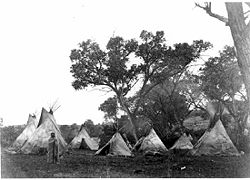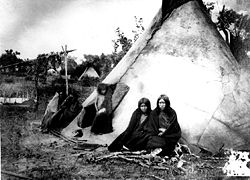Difference between revisions of "Arapaho" - New World Encyclopedia
Rosie Tanabe (talk | contribs) (imported) |
|||
| Line 13: | Line 13: | ||
|related=[[Cheyenne]] and other [[Algonquian]] peoples | |related=[[Cheyenne]] and other [[Algonquian]] peoples | ||
}} | }} | ||
| − | + | ||
The '''Arapaho''' (in [[French language|French]]: ''Gens de Vache'') tribe of [[Native Americans in the United States|Native Americans]] historically living on the eastern [[Great Plains|plains]] of [[Colorado]] and [[Wyoming]]. They were close allies of the [[Cheyenne]] tribe and loosely aligned with the [[Sioux]]. [[Arapaho language|Arapaho]] is an [[Algonquian|Algonquian language]] closely related to [[Gros Ventre]], who are seen as an early offshoot of the Arapaho. [[Blackfoot]] and Cheyenne are the other Algonquian languages on the Plains, but are quite different from Arapaho. By the 1850s, Arapaho bands separated into two tribes: the Northern Arapaho and Southern Arapaho. The Northern Arapaho Nation has lived since 1878, with the Eastern [[Shoshone]] on the [[Wind River Reservation]], the seventh largest reservation in the United States. The Southern Arapaho Tribe lives with the Southern Cheyenne in Oklahoma.[[Image:Scabby Bull, Arapaho 1806.gif|thumb|left|210px|Scabby Bull, Arapaho]] | The '''Arapaho''' (in [[French language|French]]: ''Gens de Vache'') tribe of [[Native Americans in the United States|Native Americans]] historically living on the eastern [[Great Plains|plains]] of [[Colorado]] and [[Wyoming]]. They were close allies of the [[Cheyenne]] tribe and loosely aligned with the [[Sioux]]. [[Arapaho language|Arapaho]] is an [[Algonquian|Algonquian language]] closely related to [[Gros Ventre]], who are seen as an early offshoot of the Arapaho. [[Blackfoot]] and Cheyenne are the other Algonquian languages on the Plains, but are quite different from Arapaho. By the 1850s, Arapaho bands separated into two tribes: the Northern Arapaho and Southern Arapaho. The Northern Arapaho Nation has lived since 1878, with the Eastern [[Shoshone]] on the [[Wind River Reservation]], the seventh largest reservation in the United States. The Southern Arapaho Tribe lives with the Southern Cheyenne in Oklahoma.[[Image:Scabby Bull, Arapaho 1806.gif|thumb|left|210px|Scabby Bull, Arapaho]] | ||
| Line 33: | Line 33: | ||
The late Eugene Ridgely, a Cheyenne-Northern Arapaho artist, is generally credited with bringing to light the fact that Arapahos were involved with the Massacre. His children, Eugene "Snowball" Ridgely, and Gail Ridgely, have been instrumental in designating the massacre site as a National Historic Site. | The late Eugene Ridgely, a Cheyenne-Northern Arapaho artist, is generally credited with bringing to light the fact that Arapahos were involved with the Massacre. His children, Eugene "Snowball" Ridgely, and Gail Ridgely, have been instrumental in designating the massacre site as a National Historic Site. | ||
| + | |||
| + | ==Language== | ||
| + | The '''Arapaho language''' (also Arapahoe) is a [[Plains Algonquian languages|Plains Algonquian language]] (an areal rather than genetic grouping) spoken almost entirely by elders in Wyoming. The language, which is in great danger of becoming extinct, has diverged very significantly phonologically from its posited proto-language, [[Proto-Algonquian language|Proto-Algonquian]]. | ||
==Literary reference== | ==Literary reference== | ||
Revision as of 14:12, 25 July 2008
| Arapaho |
|---|
| Total population |
| 5,000 |
| Regions with significant populations |
| United States (Colorado, Oklahoma, Wyoming) |
| Languages |
| English, Arapaho |
| Religions |
| Christianity, other |
| Related ethnic groups |
| Cheyenne and other Algonquian peoples |
The Arapaho (in French: Gens de Vache) tribe of Native Americans historically living on the eastern plains of Colorado and Wyoming. They were close allies of the Cheyenne tribe and loosely aligned with the Sioux. Arapaho is an Algonquian language closely related to Gros Ventre, who are seen as an early offshoot of the Arapaho. Blackfoot and Cheyenne are the other Algonquian languages on the Plains, but are quite different from Arapaho. By the 1850s, Arapaho bands separated into two tribes: the Northern Arapaho and Southern Arapaho. The Northern Arapaho Nation has lived since 1878, with the Eastern Shoshone on the Wind River Reservation, the seventh largest reservation in the United States. The Southern Arapaho Tribe lives with the Southern Cheyenne in Oklahoma.
There is no direct historical or archaeological evidence to suggest how and when Arapaho bands entered the Plains culture area. The Arapaho Indian tribe most likely lived in Minnesota and North Dakota before entering the Plains. Before European expansion into the area, the Arapahos were living in South Dakota, Nebraska, Colorado, Wyoming, and Kansas. They lived in teepees which the women made from bison hide. Before they were sent to reservations, they migrated often chasing herds, so they had to design their teepees so that they could be transported easily. It is said that a whole village could pack up their homes and belongings and be ready to leave in only an hour. In winter the tribe split up into small camps sheltered in the foothills of the Rocky Mountains in present-day Colorado. In late spring they moved out onto the Plains into large camps to hunt buffalo gathering for the birthing season. In mid-summer Arapahos traveled into the Parks region of Colorado to hunt mountain herds, returning onto the Plains in late summer to autumn for ceremonies and for collective hunts of herds gathering for the rutting season.
They originally used dogs to pull travois with their belongings on them. When the Europeans came to North America, the Arapaho saw the Europeans' horses and realized that they could travel quicker and further with horses instead of dogs. They raided other Indian tribes, primarily the Pawnee and Comanche, to get the horses they needed.
Later on, they became great traders and often sold furs to other tribes and non-Indians. The name 'Arapaho' might have come from the Pawnee word for 'traders.'
The children often fished and hunted with their fathers for recreation. While they had more chores to do than present-day Arapaho, they still had time to play games. They played many games, including one involving a netted hoop and a pole where they would try to throw their pole through the center of the net. It was much like the game of darts which is enjoyed today.
In July of 2005, Arapahos won a contentious court battle with the State of Wyoming to get into the gaming or casino industry. The 10th Circuit Court ruled that the State of Wyoming was acting in bad faith when it would not negotiate with the Arapahos for gaming. Presently, the Arapaho Tribe owns and operates high-stakes, Class III gaming at the Wind River Casino, Little Wind Casino and 789 Smoke Shop & Casino. They are regulated by a Gaming Commission composed of three Tribal members. The Northern Arapaho Tribe opened the first casinos in Wyoming.
During November 1864, a small village of Cheyenne and Arapaho became the victims of a controversial attack by the Union Army, led by Colonel John Chivington. This attack is now known as the Sand Creek Massacre.
The late Eugene Ridgely, a Cheyenne-Northern Arapaho artist, is generally credited with bringing to light the fact that Arapahos were involved with the Massacre. His children, Eugene "Snowball" Ridgely, and Gail Ridgely, have been instrumental in designating the massacre site as a National Historic Site.
Language
The Arapaho language (also Arapahoe) is a Plains Algonquian language (an areal rather than genetic grouping) spoken almost entirely by elders in Wyoming. The language, which is in great danger of becoming extinct, has diverged very significantly phonologically from its posited proto-language, Proto-Algonquian.
Literary reference
In Centennial, James A. Michener's epic historical novel about the West from prehistoric to modern times, the fourth chapter is about the Arapahoe peoples and their customs.
See also
- Arapaho language
- Arapahoe County, Colorado
- Arapahoe, Colorado
- Arapahoe, Wyoming
- Wind River Indian Reservation
- Native American tribes in Nebraska
External links
Credits
New World Encyclopedia writers and editors rewrote and completed the Wikipedia article in accordance with New World Encyclopedia standards. This article abides by terms of the Creative Commons CC-by-sa 3.0 License (CC-by-sa), which may be used and disseminated with proper attribution. Credit is due under the terms of this license that can reference both the New World Encyclopedia contributors and the selfless volunteer contributors of the Wikimedia Foundation. To cite this article click here for a list of acceptable citing formats.The history of earlier contributions by wikipedians is accessible to researchers here:
The history of this article since it was imported to New World Encyclopedia:
Note: Some restrictions may apply to use of individual images which are separately licensed.

